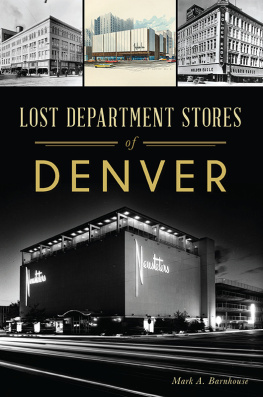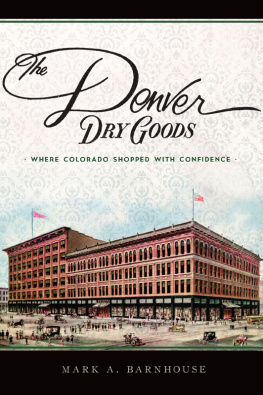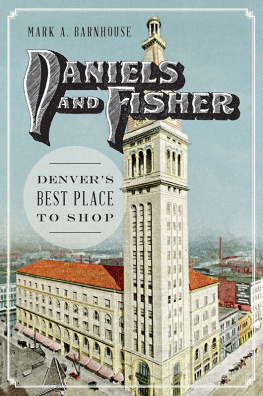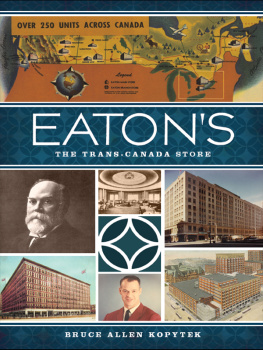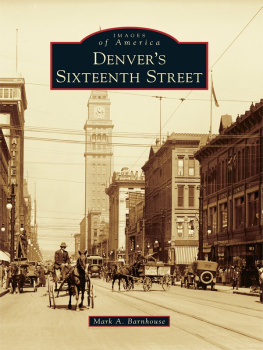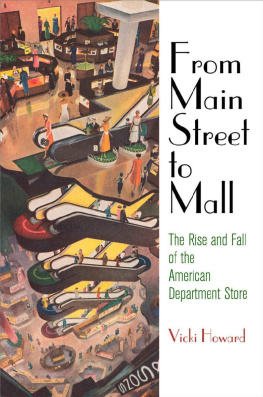


Published by The History Press
Charleston, SC
www.historypress.com
Copyright 2018 by Mark A. Barnhouse
All rights reserved
Front cover: Neusteters Cherry Creek (main image), History Colorado, Neusteter Collection, 10027909; A.T. Lewis & Son (top left), Denver Public Library, Western History Collection, X-24116; Fashion Bar architectural rendering (top center), Beck Archives, Special Collections, CJS and University Libraries, University of Denver; the Golden Eagle (top right), History Colorado, 10040053.
First published 2018
e-book edition 2018
ISBN 978.1.43966.585.5
Library of Congress Control Number: 2018948043
print edition ISBN 978.1.46713.840.6
Notice: The information in this book is true and complete to the best of our knowledge. It is offered without guarantee on the part of the author or The History Press. The author and The History Press disclaim all liability in connection with the use of this book.
All rights reserved. No part of this book may be reproduced or transmitted in any form whatsoever without prior written permission from the publisher except in the case of brief quotations embodied in critical articles and reviews.
To Janice Miller Wallington (19382017); also, to Della, a dog with a nose for fashion.
CONTENTS
ACKNOWLEDGEMENTS
Writing a book is never a solitary effort. This my third book on Denvers department stores, and Im grateful to everyone who has helped along the way. Although some of these names have not contributed directly to this volume, they have helped it nevertheless, as the two previous works inform this one.
For advice, tips, stories and encouragement; for facilitating connections with others; or for help in obtaining images, I am indebted to the following individuals: Kristen and Robert Autobee, Sandra Barnhouse, Mark Bochnak and Richard Bruce, Jean-Pierre Chardeaux, Kathleen Corbett, Sandra Dallas, Bill Eloe, Alan Golin Gass, Lois Harvey, F. Joseph Hayes, Richard Hentzell, Leslie Mohr Krupa, Linda Lebsack, Robert J. Levy, Red Nichols, Thomas J. Noel, Jim OHagan, Mary ONeil, Heather Ormsby, Judy and Ron Proctor, Virginia Ronzio Owens, Susan Powers, Marilyn Quinn, Bob Rhodes, Tom Rowan, Tom and Laurie Simmons, Joe Sokolowski, Jodi Sokup, Judy Stalnaker, Shantelle Stephens, Matthew Sullivan, Israela Vera, Nan Walker and Roger Whitacre.
As usual, I have depended on Denvers archives for research and images. At Denver Public Library Western History Collection, I thank Coi Drummond-Gehrig and Katie Rudolph for excellent help, along with their colleagues at the fifth-floor desk and Mullen Manuscript Room. Thanks also to Melissa Lawton of the Stephen H. Hart Library, History Colorado. Jeanne Abrams and Thyria Wilson at the Ira M. and Peryle Hayutin Beck Memorial Archives of the Rocky Mountain Jewish Historical Society at the University of Denver helped particularly with the Fashion Bar and Golden Eagle chapters, for which I am grateful.
I also thank those who have asked me to speak to audiences about Denvers department stores and other topics. These engagements have led to unexpected connections that made writing this book and the two previous interesting and fun, contributing to the process. These include Ryan Warner and Nathan Heffel (Colorado Public Radio); Steve Friesen and Reed Weimer (The Denver Posse of Westerners); Larry Bohning (Denver Rotary Club); Carol Hiller and Kyle Long (Doors Open Denver/Denver Architecture Foundation); Shawn Snow, Michael Vincent and Jack Wheeler (History Colorado); and Phyllis Larison (Bemis Public Library, Littleton).
Special thanks go to Artie Crisp at The History Press for his help, advice, enthusiasm and flexibility, as well as to Ryan Finn for his thoughtful editing.
Finally, thank you to Matt Wallington, for everything you do.
Authors note: Chapters are arranged in chronological order of each stores founding. Subtitles derive from advertising slogans used at some point during each stores history.
Introduction
ENTREPT OF THE WEST
The department store rose to prominence over a century ago in part because it satisfied some basic human needs beyond the desires of consumption.
Richard Longstreth, The American Department Store Transformed, 19201960
THE DEPARTMENT STORE
In the twenty-first century, it is increasingly difficult for most Denver residents to remember the role that local department stores once played in their lives. Before online shopping, big-boxes and chain discounters, Denvers department stores were the first choices of the middle and upper classes. These emporia, sprawling across multiple floors on prime downtown corners, carried just about everything: complete lines of clothing, shoes and accessories for everyone in a household and myriad other items like cosmetics; jewelry; linens; china, glass and silverware; furniture; toys and games; fresh-cut flowers; gifts; stationery and books; sporting goods; candy and gourmet foods; televisions and radios; records and record players; luggage; small and major appliances; and, in the case of one Denver store, everything required by the professional working stockman, including saddles.
Denvers stores were about more than just the goods they carried, however. They also provided services. Businessmen could get their shoes shined in a few minutes or resoled in a few days. Marrying couples could set up gift registries. Women meeting friends for shopping could enjoy comfortable lounges, perhaps dashing off a letter with store-provided stationery. Arts patrons could pick up theater or symphony tickets. Vacationers could book tickets and rooms with a travel agent. Those with tight budgets could put items on layaway, paying a little at a time (they could also find great values in bargain basements). People could mail packages or letters instead of trekking to the post office. Gift-givers could have purchases wrapped elegantly. Families could have portraits taken in photo studios, and women could have their hair shampooed, cut and set. When everyones needs had been met, they could meet for lunch or mid-afternoon nosh in genteel in-store tearooms before heading home. And if they had bought something too large to carry on the streetcar or just didnt want the burden, the store could deliver it.
No one Denver store offered everything, but what most had in common were service levels we would find unusual in the twenty-first century, even in luxury stores. In the late nineteenth and early twentieth centuries, customers sat in front of sales counters while clerks brought them items to examine self service was unheard of. For the affluent, clerks brought goods to the lady waiting in her carriage so she would not have to mingle with the masses (several Denver stores claimed to have served Baby Doe Tabor, second wife of Silver King Horace Tabor, this way). All quality merchants followed the famous dictum of Chicagos Marshall Field: give the lady what she wants, with the unspoken corollary, shes always right, even when shes not. Purchases werent just tossed into sacks, but were wrapped in paper and tied with string or placed in boxes with tissue paper. Clerks remembered customers names and knew their tastesif something came in they knew Mrs. Smith would like, they would send her a note. Great service engendered strong customer loyalty.
Next page
